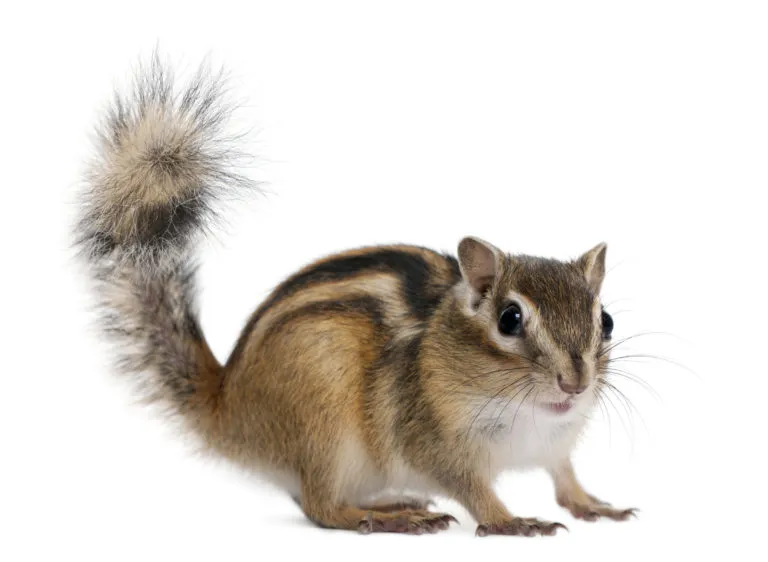The Siberian chipmunk is becoming increasingly popular as a pet. Due to its lively ways, its button eyes and its cute appearance, more and more people are falling under its charms. That said, these pint-sized pets are more demanding than they first appear to be.
All about caring for your Siberian chipmunk
In captivity, Siberian chipmunks have a life expectancy of around 7 years. This pet rodent is totally unsuitable for children as it should only be observed and shouldn’t be cuddled and stroked.
The original habitat of the Siberian chipmunk is in China, northern Japan, Mongolia and Siberia. It mostly lives in burrows in mixed and coniferous forests full of undergrowth. It has its own territory which it defends from others of the same species. It can only tolerate other chipmunks in its territory for a short time during mating season.
Most of the day is spent searching for food which mainly consists of buds and seeds found in that region. They also consume animal protein in the form of insects.
Siberian chipmunks are very good climbers. They climb using the balls of their feet and their claws with their tail for support.
Shortly after hibernation is over, comes mating season. The female makes a whistling sound to let the males know that she is ready for mating season. After a pregnancy that lasts 29-31 days, three to eight pups on average are born. The pups are weaned from the mother at about 8 weeks old.
Birds of prey, martens, foxes, wildcats and lynxes are all natural predators of the Siberian chipmunk.
Nutrition
Pet shops offer many feed mixes suitable for Siberian chipmunks. In addition to this, Siberian chipmunks like to have millet, safflower, canary seeds, flax seeds, oats etc in the outer shells. This offers not only a change in diet but also keeps them busy. On top of that, two to three different nuts should be given daily. You can give your pet meal worms, crickets or superworms as a source of protein but it should have 2 protein-free days a week.
Fruit and vegetables should be given every day. Cabbage and salad are not suitable as they cause gas and badly disturb the digestion of this small rodent.
In order to be sure that your Siberian chipmunk is getting enough minerals, you should place a mineral stone and a cuttlebone in the cage. A water bottle which is refilled daily is enough to meet your pet’s hydration needs. Be careful, not every chipmunk knows how to use the water bottle, especially in the first weeks so a water bowl should also be provided.
Running around
A Siberian chipmunk should be given 4 to 6 weeks to get used to you, then after that time it should be allowed to run around the room at home freely. Before this can happen, the chipmunk must be fully tame so that it doesn’t try to hide. It should be given at least one hour every day to run around but more time is of course better. Anything that poses a danger, such as, poisonous plants, cables, cleaning materials, medicines etc should be removed.
Behaviour
Siberian chipmunks are active during the daytime. They live very solitary lives and don’t tolerate others of the same species. If chipmunks are kept together it will often end in a deadly fight.
In the autumn, Siberian chipmunks will gather their food stocks, this can also bring about aggressive behaviour towards the owner. Bites and scratches can often occur during this time. In winter many chipmunks will hibernate. They rarely come out and when they do emerge into the cage or run around the room, this only lasts a short time. Some chipmunks will spend a few weeks sleeping in their nest and should not be disturbed during this time. Their metabolism shuts down and any disturbance could weaken the animal unnecessarily.
Keeping chipmunks in a cage
These pets have an enormous need to run around. Chipmunks in captivity should be kept in large aviaries with at least 1 meter squared of floor space and a height of 2 meters. An aviary for a chipmunk can quickly become too small but can never be too big.
Accessories for the cage
Provide your chipmunk with two or three budgies nests as a place to sleep or shelter. Climbing branches with a diameter of 3 to 4 centimetres are an essential. Grass nests without a wire rack, flower pots, small vases, cork tubes and logs can all be enjoyed as hiding places. A viewing perch where the chipmunk can eat and relax can be made out of a flat board. Some chipmunks have a fixed toilet corner and you can place a bowl with straw or chinchilla sand there to make cleaning up a little easier.
In order to keep their coat clean and to satisfy their natural urge to create tunnels and burrows, chipmunks need a dust bath. This can be a small aquarium or a large flower pot. For the dust you can use potting soil without fertiliser or a coconut husk brick.
